Experimental Study on Sand and Wax Composite Deposition in Bozi Dabei Condensate Gas Well in Tarim Oilfield
Donghong Guo1,2*, Jun Li1,2, Xiaopeng Yang1,2, Yi Zhang1,2 and Yan Liu1,2
1Department of Oil & Gas Production Engineering, Research Institute of Petroleum Exploration & Development, PetroChina, China
2Key Laboratory of Oil & Gas Production, CNPC, China
Submission: September 22, 2022; Published: September 30, 2022
*Corresponding author: Donghong Guo, Department of Oil & Gas Production Engineering, Research Institute of Petroleum Exploration & Development, PetroChina, 20 Xueyuan Road, Beijing 100083, China
How to cite this article: Guo DH, Li J, Yang XP, Zhang Y, Liu Y. Experimental Study on Sand and Wax Composite Deposition in Bozi Dabei Condensate Gas Well in Tarim Oilfield. Eng Technol Open Acc. 2022; 4(3): 555637. DOI: 10.19080/ETOAJ.2022.04.555637
Abstract
Based on the similarity principle, a thin tube with similar size and geometry to the field wellbore was designed. Simulated condensate oil samples were prepared by using field condensate oil samples and wax samples, and sand samples with different particle sizes were used to simulate wellbore sand production. The influence of sand sample particles on wax deposition process of simulated condensate oil was studied. The results showed that in the particle size range of 0.109mm~0.85mm, with the increase of sand content from 1% to 9%, the amount of wax deposition increased continuously, and the amount of wax deposition increased with the increase of sand particle size. When the temperature of wax deposition decreased from 50℃ to 40℃, the amount of wax deposition increased obviously under different sand addition conditions; When the wax content of simulated condensate oil increased from 10% to 13%, the amount of wax deposition increased obviously under different sand addition conditions. The research results had certain guiding significance for the development and screening of composite plugging remover in site.
Keywords:Tarim oilfield; Condensate gas reservoir; Simulated condensate oil; Sand particle; Composite deposition
Introduction
During the production of high waxy condensate gas reservoir and oil reservoir, with the change of temperature, pressure and environmental conditions, wax deposition would occur in the near wellbore, wellbore, and surface pipeline. The wax deposition in the near wellbore could reduce the porosity and permeability of reservoir, and the wax deposition in wellbore and surface pipeline could cause the blockage of wellbore and surface pipeline or even shut-in, which would seriously affect the normal production of condensate gas wells and oil wells [1-4]. There were many factors affecting wax deposition, such as gas-oil ratio, condensate oil composition, flow rate, pH value and various particles besides temperature and pressure [5,6]. Particles mainly resulted from scaling, sand production, corrosion products and mechanical impurities in oil and gas wells. Inorganic substances such as scale, corrosion products, fine sand particles and mechanical impurities in wellbore could provide crystallization centers for the deposition of organic wax, that is, wax could grow slowly around reservoir particles, thus intensifying wax deposition. At the same time, under the joint action of wax deposition, particulate matter was easy to form aggregates in the wellbore, which further aggravated the risk of wellbore plugging, that is, inorganic-organic co-deposition [5,7,8]. Once inorganic-organic composite plugging was formed, it would greatly increase the difficulty of on-site plugging removal.
As of June 2022, the plugged wells in Bozi block of Tarim deep high temperature and high-pressure condensate gas reservoir accounted for 17%, among which wax plugging was the main one, and sand and wax composite plugging appeared at the same time. The plugged wells in Dabei block accounted for 36%, among which scale plugging was the main one, and composite plugging of wax and scale occurred at the same time. The influence of inorganic particles on wax deposition had been studied [5,6], but there were few reports on the influence of inorganic particles with different particle sizes on wax deposition, especially on the composite plugging of wellbore in Tarim high temperature and high-pressure condensate gas reservoir. In order to explore the mechanism of inorganic particles affecting wax deposition and provide theoretical basis for removing inorganic-organic composite plugging, an experimental study on the effects of inorganic particles content and different particle size ranges on wax deposition was carried out.
Experimental Section
Main Equipment and Materials
Sample dispenser, pressure sensor, temperature sensor, 5 sections 6mm thin tubes, constant temperature water bath, nitrogen cylinder, supercharger, dryer, etc. Degassed condensate oil and wax samples in Bozi 12 well, nitrogen and sand samples with different particle sizes 0.425mm-0.85mm, 0.212mm- 0.425mm, 0.109mm-0.212 mm.
Preparation of Simulated Condensate oil
The preparation method of simulated condensate oil was as follows: open the sample preparation container, weigh 124.2 g condensate oil, add 13.81 g and 18.56 g wax samples respectively, prepare two kinds of simulated condensate oil with wax content of 10% and 13%, start to heat up to 70℃, and start the stirring system to keep the temperature stirring system stable for more than 8 hours to ensure that the wax samples were fully dissolved. The initial temperature for preparing simulated condensate fluid samples was 70℃, and the experimental water bath temperatures were 40℃and 50℃ respectively.
Simulated condensate oil wax deposition experiment
Based on the similarity principle, Design thin tubes with geometric similarity to the size of field wellbore. Using field condensate oil samples and wax samples to prepare simulated condensate oil samples, Sand samples with different particle sizes were used to simulate inorganic particles or sand production in wellbore, sand samples were filled into the first section thin tube, and prepared simulated condensate oil samples were injected, wax deposition was carried out by static cooling, and the quality of thin tubes was weighed before and after the experiment, and the quality difference was the sum of wax deposition and residual sand samples. After the thin tube experiment, the recovery liquid flowing out of the fifth thin tube was separated, dried and weighed to obtain the quality of sand samples flowing out of the thin tube. According to the quality of sand samples initially added into the thin tube, the residual sand samples in the thin tube could be calculated, and then the wax deposition amount in the thin tube could be calculated according to the quality difference of the thin tube before and after the experiment.
Results and Discussion
Effect of sand addition on solid deposition amount and wax deposition amount
At the experimental temperature of 50℃ and the wax content of simulated condensate oil of 10%, three kinds of sand particles with different particle sizes 0.425 mm-0.85mm, 0.212mm- 0.425mm, 0.109mm-0.212mm were added, and the change of solid deposition amount in simulated condensate oil was shown in (Figure 1). As could be seen from (Figure 1), the amount of solid deposition increased with the increase of sand addition amount. Moreover, the larger the particle size of sand samples, the greater the amount of solid deposition. It could also be seen from (Figure 1) that the increase of solid deposition amount was the largest when the increment of sand addition was 0%-1%, and with the increase of sand addition amount, the increase of solid deposition amount gradually slowed down (Figure 1).
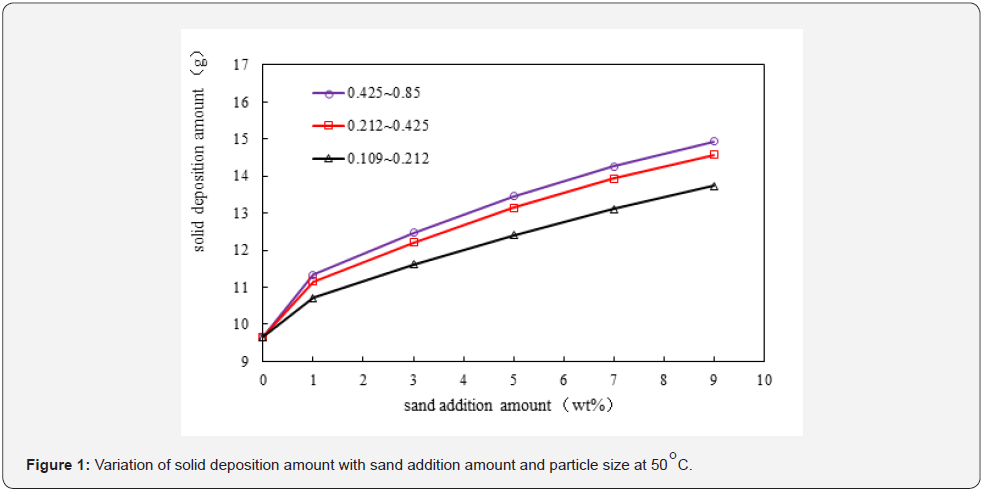
The solid deposition amount consisted of sand deposition amount and wax deposition amount. In order to analyze the composition of solid deposition in thin tubes, after each thin tube wax deposition experiment, the recovery liquid flowing out of the fifth thin tube was separated, dried and weighed to obtain the sand sample mass flowing out of the thin tube. According to the sand sample mass initially added into the thin tube, the residual sand sample mass in the thin tube could be calculated, and then the wax deposition amount in the thin tube could be calculated. The actual measurement results showed that, in the process of all thin tube wax deposition experiments, more than 90% of the sand samples had been carried out by the fluid and entered the recovery solution after all the simulated condensate samples flowed through the thin tube. Therefore, it could be considered that the increase of solid deposition in the thin tube was mainly due to the contribution of wax deposition, and the residual sand samples only accounted for a small proportion. Corresponding to the experimental conditions in (Figure 1), according to the fact that 90% of sand samples were carried out by fluid, the change of wax deposition amount in thin tubes with sand addition amount could be calculated as shown in (Figure 2). It could be seen that the amount of wax deposition in thin tubes also increased with the increase of sand addition, because after adding sand, sand could acted as the crystallization center of wax, which made wax more easily deposited [9-11]. Moreover, with the increase of sand particle size, the amount of wax deposition increased gradually, because the larger the sand particle size, the more wax crystals were adsorbed to the surface of sand particles, and then enhanced the co-deposition of sand and wax. It could be seen from the corresponding relationship between (Figures 1 & 2) that the change trend of wax deposition amount and solid deposition amount was consistent (Figures 1&2).
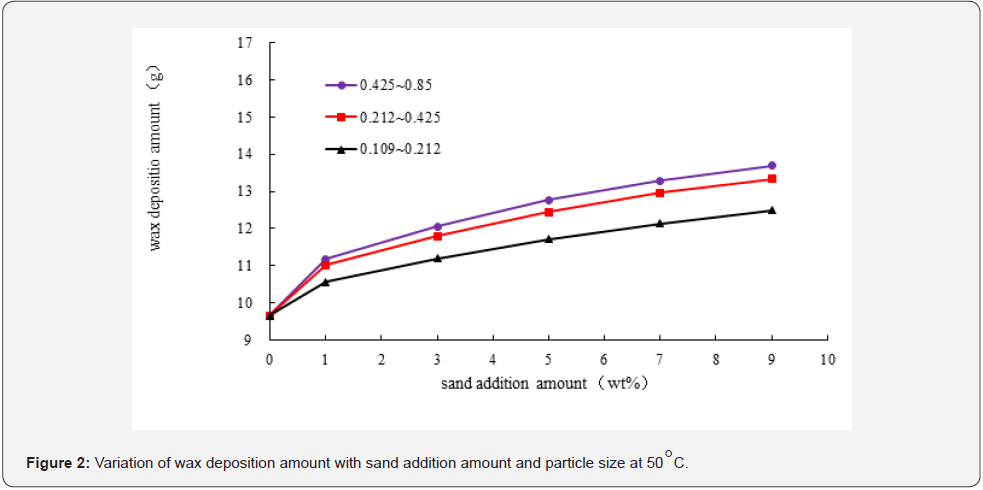
Temperature was an important factor affecting wax deposition. Sand particles with particle size range 0.425mm- 0.85mm were selected, and under the condition of wax content of simulated condensate oil of 10%, the total amount of solid deposition was obtained through thin tube wax deposition experiment at different temperatures, as shown in Figure 3. It could be seen from (Figure 3) that under the condition of 1%-7% sand addition, the total amount of solid deposition decreased with the increase of temperature, that is, the trend of sand and wax codeposition decreased. With the increase of sand addition amount, the amount of solid deposition increased accordingly. In order to further analyze the composition of solid deposition in thin tubes, according to the fact that 90% of sand samples were carried out by fluid, the variation of wax deposition amount with sand addition amount at different temperatures could be calculated as shown in (Figure 4). As could be seen from (Figure 4), the amount of wax deposition in the thin tubes decreased with the increase of temperature, because the trend of wax deposition decreased with the increase of temperature (Figure 4).
Wax content was also an important factor affecting wax deposition. Sand particles with particle size range 0.425mm- 0.85mm were selected. Under the experimental temperature of 50℃, the total amount of solid deposition was obtained through the thin tube wax deposition experiment of simulated condensate oil with different wax content, as shown in (Figure 5). It could be seen from (Figure 5) that under the condition of 1%-7% sand addition, the total amount of solid deposition increased with the increase of wax content, because the higher the wax content of simulated condensate oil, the more favorable it was for the codeposition of sand and wax. With the increase of sand addition, the amount of solid deposition also increased correspondingly (Figure 5).
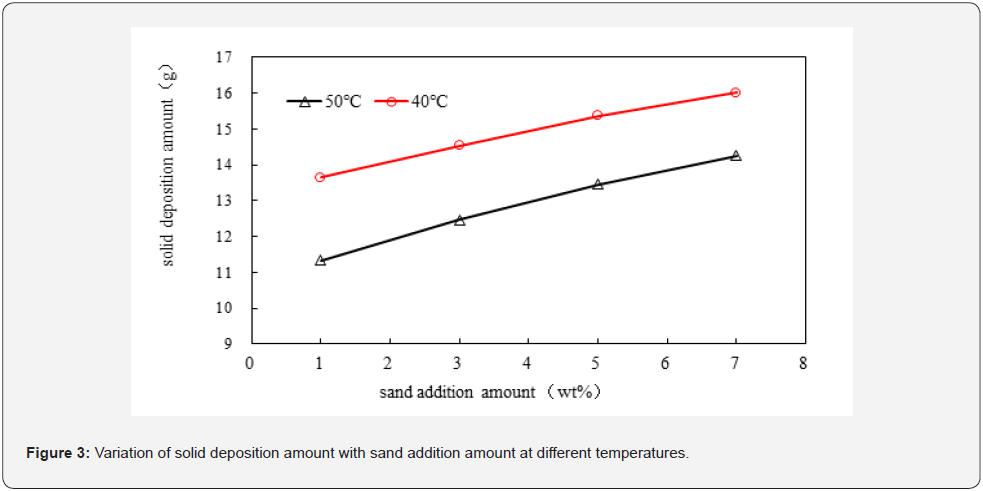
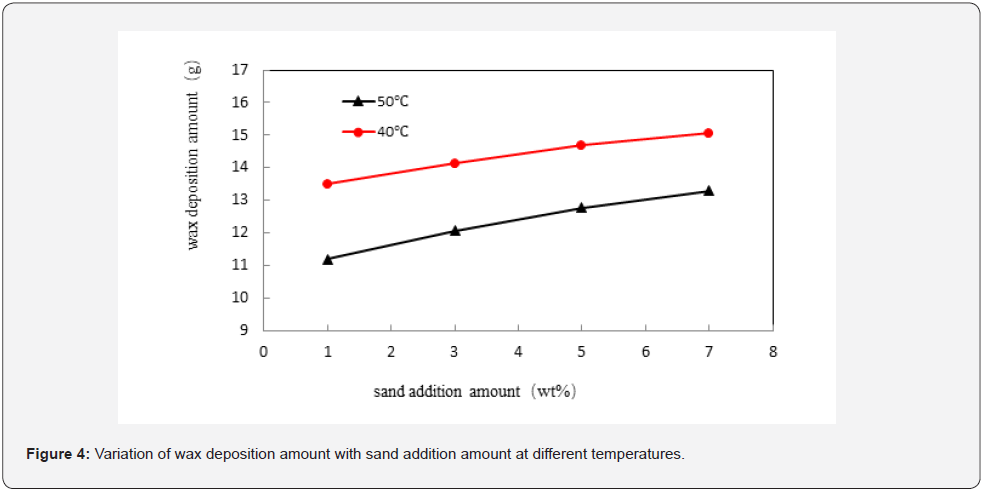
In order to further analyze the composition of solid deposition in thin tubes, according to 90% of sand samples being carried out by fluid, the change of wax deposition amount in thin tubes with sand addition amount under different wax contents could be calculated, as shown in (Figure 6). As could be seen from (Figure 6), with the increase of wax content, the amount of wax deposition in thin tubes increased, because the trend of wax deposition increased with the increase of wax content.
Conclusion
i. The introduction of sand particles provided crystallization center for wax deposition, which was more conducive to wax deposition. The greater the amount of sand addition, the greater the amount of wax deposition, that is, organic-inorganic composite deposition was formed.
ii. Under the condition of the same amount of sand addition, the amount of wax deposition increased with the increase of particle size.
iii. Under the condition of the same amount of sand addition, the deposition of wax was more favorable with the decrease of system temperature and the increase of wax content.
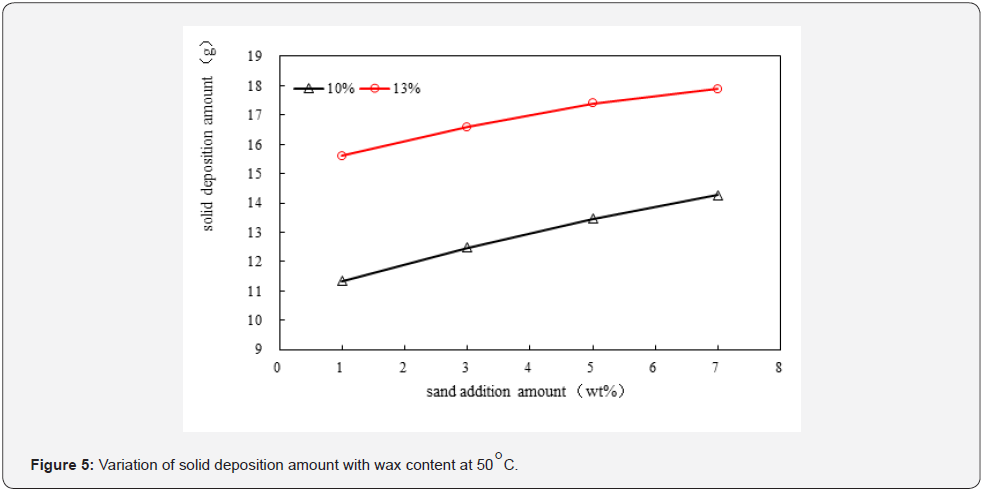
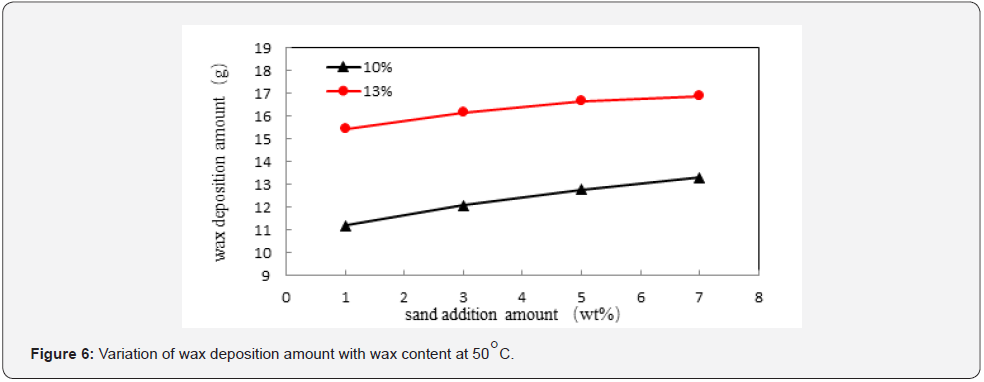
Acknowledgement
The authors are grateful to PetroChina Exploration& Production Company and Southwest Petroleum University for their support of this study.
References
- Ren CQ, Luo Y, Sun L, et al. (2011) Wax precipitation research of high-waxy condensate gas wellbore. Journal of Chongqing University of Science and Technology (Natural Sciences Edition) 13(3): 61-64.
- Cai H, Huang C (2011) Experimental study on wax deposit of high-waxy condensate gas well. Petrochemical Industry Application 30(3): 20-22.
- Liu YL (2019) Paraffin remover and inhibitor and their application to HTHP condensate reservoirs, Bozi block. Natural Gas Technology and Economy 13(4): 40-45.
- Zhong C, Wang J, Liu JQ, Huang Yixiao, Yang Xiangtong et al. (2019) Software simulation and experimental study on the law of wax deposition pattern in deep condensate gas. Journal of Petrochemical Universities 32(5): 96-100.
- Zhou F, Dai QQ (2021) Experimental study on influencing factors of wax deposition in high waxy crude oil. Technology Supervision in Petroleum Industry 37(7): 6-9.
- Huang HP, Wei X, Zhong H, et al. [2014] Research on the influence factor of water-free crude oil paraffining. Journal of Chongqing University of Science and Technology (Natural Sciences Edition) 16(4): 64-68.
- Wu WM, Hou JR (2022) Analysis on components and origin of the well blockage in one Xinjiang oilfield. Oilfield Chemistry 39(2): 49-354.
- Yang LX, Guo DH, Xie HZ, et al. (2007) Study on mechanism of organic –inorganic complex plugging for Well 8001 in Kenjiyak oilfield. Chemical Engineering of Oil & Gas 36(5): 412-415.
- Yang H, Chen DJ, Luo Y (2009) Influences of injected fluids on determining wax appearance temperature of crude oils. Journal of Oil and Gas Technology 31(2): 142-144.
- Li ZX (2022) Cause analysis of wellbore waxing formation and degree prediction in a block of North China. World Petroleum Industry 29(4): 61-66.
- Lei Q, Wang W, Dong JG, et al. (2021) Wax formation mechanism and wax deposition law of wellbores in an oilfield block. Petroleum Engineering Construction 47(2): 15-19.






























